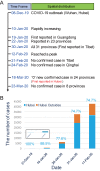Virology, Epidemiology, Pathogenesis, and Control of COVID-19
- PMID: 32230900
- PMCID: PMC7232198
- DOI: 10.3390/v12040372
Virology, Epidemiology, Pathogenesis, and Control of COVID-19
Abstract
The outbreak of emerging severe acute respiratory syndrome coronavirus 2 (SARS-CoV-2) disease (COVID-19) in China has been brought to global attention and declared a pandemic by the World Health Organization (WHO) on March 11, 2020. Scientific advancements since the pandemic of severe acute respiratory syndrome (SARS) in 2002~2003 and Middle East respiratory syndrome (MERS) in 2012 have accelerated our understanding of the epidemiology and pathogenesis of SARS-CoV-2 and the development of therapeutics to treat viral infection. As no specific therapeutics and vaccines are available for disease control, the epidemic of COVID-19 is posing a great threat for global public health. To provide a comprehensive summary to public health authorities and potential readers worldwide, we detail the present understanding of COVID-19 and introduce the current state of development of measures in this review.
Keywords: COVID-19; SARS-CoV-2; epidemiology; pathogenesis; therapeutics.
Conflict of interest statement
The authors declare no conflict of interest. The funders had no role in the design of the study; in the collection, analyses, or interpretation of data; in the writing of the manuscript, or in the decision to publish the results.
Figures





Similar articles
-
COVID-19 pandemic: an overview of epidemiology, pathogenesis, diagnostics and potential vaccines and therapeutics.Ther Deliv. 2020 Apr;11(4):245-268. doi: 10.4155/tde-2020-0035. Epub 2020 May 12. Ther Deliv. 2020. PMID: 32397911 Free PMC article. Review.
-
An overview of COVID-19.J Zhejiang Univ Sci B. 2020 May;21(5):343-360. doi: 10.1631/jzus.B2000083. Epub 2020 May 8. J Zhejiang Univ Sci B. 2020. PMID: 32425000 Free PMC article. Review.
-
The COVID-19 pandemic.J Pak Med Assoc. 2020 May;70(Suppl 3)(5):S4-S6. doi: 10.5455/JPMA.02. J Pak Med Assoc. 2020. PMID: 32515365 No abstract available.
-
Current Status of Epidemiology, Diagnosis, Therapeutics, and Vaccines for Novel Coronavirus Disease 2019 (COVID-19).J Microbiol Biotechnol. 2020 Mar 28;30(3):313-324. doi: 10.4014/jmb.2003.03011. J Microbiol Biotechnol. 2020. PMID: 32238757 Free PMC article. Review.
-
Pathophysiology and treatment strategies for COVID-19.J Transl Med. 2020 Sep 15;18(1):353. doi: 10.1186/s12967-020-02520-8. J Transl Med. 2020. PMID: 32933536 Free PMC article. Review.
Cited by
-
Ivermectin: A Controversial Focal Point during the COVID-19 Pandemic.Life (Basel). 2022 Sep 6;12(9):1384. doi: 10.3390/life12091384. Life (Basel). 2022. PMID: 36143420 Free PMC article. Review.
-
COVID-19 Pandemic: from Molecular Biology, Pathogenesis, Detection, and Treatment to Global Societal Impact.Curr Pharmacol Rep. 2020;6(5):212-227. doi: 10.1007/s40495-020-00229-2. Epub 2020 Jul 27. Curr Pharmacol Rep. 2020. PMID: 32837855 Free PMC article. Review.
-
Poor Prognostic Biochemical Markers Predicting Fatalities Caused by COVID-19: A Retrospective Observational Study From a Developing Country.Cureus. 2020 Aug 5;12(8):e9575. doi: 10.7759/cureus.9575. Cureus. 2020. PMID: 32913691 Free PMC article.
-
COVID-19 and Prostatitis: A Review of Current Evidence.Diseases. 2024 Jul 15;12(7):157. doi: 10.3390/diseases12070157. Diseases. 2024. PMID: 39057128 Free PMC article. Review.
-
Total and segmental phase angle in a cohort of hospitalised patients with COVID-19: mortality prediction and changes throughout hospitalisation.Br J Nutr. 2024 Apr 28;131(8):1397-1404. doi: 10.1017/S0007114523002994. Epub 2023 Dec 27. Br J Nutr. 2024. PMID: 38149452 Free PMC article.
References
-
- World Health Organization Press Conference The World Health Organization (WHO) Has Officially Named the Disease Caused by the Novel Coronavirus as COVID-19. [(accessed on 11 February 2020)]; Available online: https://www.who.int/emergencies/diseases/novel-coronavirus-2019.
-
- Gorbalenya A.E., Baker S.C., Baric R.S., de Groot R.J., Drosten C., Gulyaeva A.A., Haagmans B.L., Lauber C., Leontovich A.M., Neuman B.W., et al. Severe acute respiratory syndrome-related coronavirus: The species and its viruses—A statement of the Coronavirus Study Group. bioRxiv. 2020 doi: 10.1101/2020.02.07.937862. - DOI
Publication types
MeSH terms
Substances
Grants and funding
LinkOut - more resources
Full Text Sources
Other Literature Sources
Medical
Research Materials
Miscellaneous

